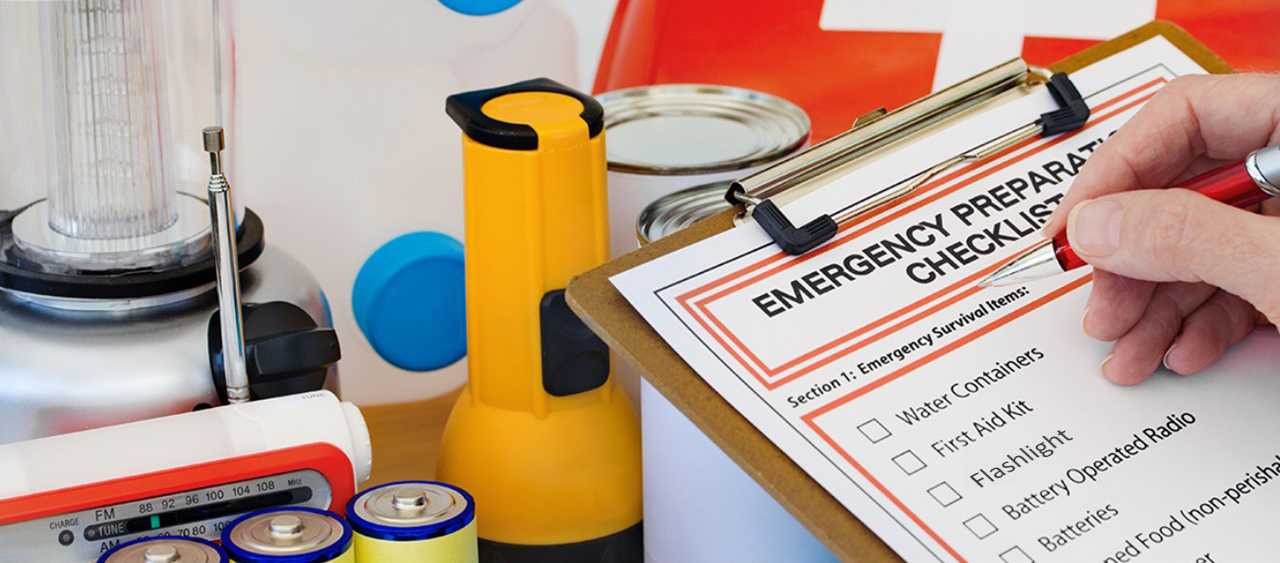Get a Kit

If a disaster strikes in your community, you might not have access to food, water, or electricity for several days. Preparing an emergency kit for your family is an important step in keeping them safe and healthy during an emergency.
Pack an emergency supply kit. Be sure to include:
At Least a 3-day Supply of Food and Water
Are You Prepared?
Get more information about how to create and store an emergency water supply and prepare your emergency food supply.
Health Supplies
- 3-day supply of all medicines, at a minimum
- Medical supplies like syringes, a walking cane, or hearing aids with extra batteries
Personal Care Items
- Soap
- Toothbrush and toothpaste
- Baby wipes
- Contact lenses or glasses
Safety Supplies
- First aid kit
- Emergency blanket
- Multipurpose tool (that can act as a knife, file, pliers, and screwdriver)
- Whistle
Electronics
- Flashlight
- Radio (battery-powered, solar, or hand-crank) for updates on the situation
- Cell phone with chargers
- Extra batteries
Documents
- Copies of important documents such as insurance cards and immunization records
- Paperwork about any serious or on-going medical condition
- Your completed family emergency plan, complete with family and emergency contact information.
You should also include:
- Extra cash
- Maps of the area
- Extra set of car keys and house keys
Take Care of Others
Every family is unique. You may have emergency needs not included in this list. Also, remember to update your kit according to changing needs of your family.
For Children
- Baby supplies like bottles, formula, baby food, and diapers
- Games and activities for children
For Pets
- Food and Water
- A 3-day supply of food and water for each pet. A cat or a dog will generally need 1 gallon for three days.
- Bowls or bottles
- Manual can opener
- Cleaning Supplies
- Depending on the pet, you may need a litter box, paper towels, plastic trash bags, grooming items, and household bleach
- Health and Safety
- Medicines and medical records stored in a waterproof container
- First aid kit with a pet first aid book
- Transport supplies
- A sturdy leash, harness, and carrier to transport pets safely. A carrier should be large enough for the animal to stand comfortably, turn around, and lie down. Your pet may have to stay in the carrier for several hours.
- Comfort Items
- Pet toys and the pet’s bed, if you can easily bring it, to reduce stress
- Paperwork
- Current photos and descriptions of your pets to help others identify them, and to prove that they are your pets, in case you become separated from them
- Information on feeding schedules, medical conditions, behavior problems, and the name and telephone number of your veterinarian in case you have to board your pets or place them in foster care
- Download our Pet Emergency Checklist
Quick Tips
-
Keep it fresh. It’s extremely important that all items in your kit are functional at the time of an emergency.
- Check the expiration dates on food, water, medicine, and batteries at least two times per year.
- Replace any food or supplies that may have expired.
-
Be sure it’s ready to use. In a disaster situation, you may need to get your emergency supply kit quickly, whether you are sheltering at home or evacuating.
- Once you have gathered your supplies, pack the items in easy-to-carry containers.
- Clearly label the containers and store them where you can reach them easily.
- Remember that certain items, like medications and paper documents, need to be kept in waterproof containers.
-
Involve children. Families can make emergencies less stressful by preparing in advance and working together as a team. Ready Wrigley can help!
- Ask your kids to think of items that they would like to include in an emergency supply kit, such as books, games, and pre-packaged foods.
- Your kids can mark the dates on a calendar for checking emergency supplies. Tell them to remind you when it’s time to check the supplies.
- Include kids in planning and creating disaster kits for family pets.
- Know your house. Find out where your gas, electric, and water shut-off locations are, and how to turn them off.
- Prepare for everywhere. Emergencies can happen anywhere. Remember to prepare supplies for home, work, and vehicles.
Get more information:
- Page last reviewed: October 10, 2017
- Page last updated: October 10, 2017
- Content source:


 ShareCompartir
ShareCompartir